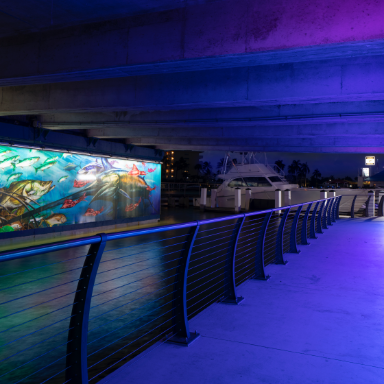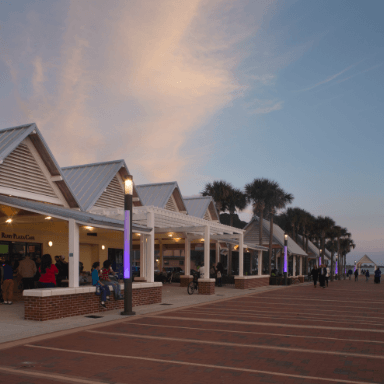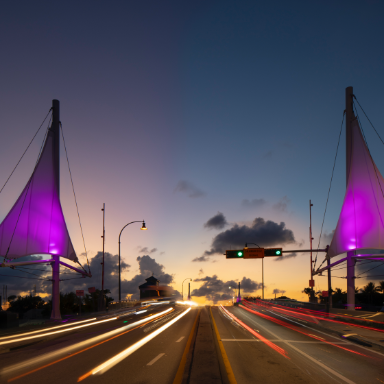LandscapeOnline.com features The Pompano Beach Streetscape and Dune Enhancement
LandscapeOnline.com • August 6, 2014

Pompano Beach: Streetscape and Dune Enhancement Landscape Architecture by EDSA
Working with the Pompano Beach Community Redevelopment Agency (CRA), EDSA led a multidisciplinary team of consultants tasked to create a plan for the beach environment and a remodeled streetscape along Florida’s Pompano Beach Boulevard. The master plan streetscape and dune enhancement has been the catalyst for a new family feel for this beach community.
Changing a blighted beachfront environment into a public resort destination was the challenge faced by the city of Pompano Beach Fla. This beach city (pop. 102,984), tucked between Deerfield Beach to the north and Fort Lauderdale to the south, is part of the greater Miami metro area (pop. 5,564,635). The city is home to the Goodyear blimp (‘Spirit of Innovation’), although that’s about to be replaced by the “state-of-the-art NT blimp.” If you're curious about the city’s name, it derives from the short-snouted game fish commonly caught off the coast, the pompano (Trachinotus carolinus). Pompano is also home to the only preserved Indian burial mound in Broward County, which was recently put on the National Register of Historic Places. Ancestors of the Tequesta Indians, as far back as 500 A.D., are buried here.
Pompano Beach and the East Community Redevelopment Agency had been unsuccessful in the revitalization of their beachfront. The city had not effectively capitalized on their most significant natural resource—the beach. With new leadership for the city and the Community Redevelopment Agency (CRA), and with the assistance of EDSA, Inc., the landscape architect, they jointly created and executed a new vision for a three-quarter of a mile beachfront corridor. The purpose of the project was to stimulate activity along the beach, and craft a vibrant and uniquely branded oceanfront promenade.
BEFORE
The terminus of Atlantic Boulevard was a blighted parking lot on the beach. This same spot is now a gateway lawn and plaza. The design intent for the beachfront promenade was a monolithic surface. It is white porcelain cement with a variety of aggregate finishes—shells in some places, and circles of glass elsewhere. With water and power infrastructure included as amenities, the lawn was configured for everyday use and special events. Wild date palms (Phoenix sylvestris) are in the foreground, with a groundcover of ‘Beach’ Verbena maritima, a native to the coastline and a good dune stabilizer.
Public Cooperation
As one of the most strategic initiatives in Pompano, the project included the public and a variety of stakeholders and consensus building meetings for those with a vested interest in the revitalization of the area. The project was intended to supplement the existing federal “beach nourishment” (sand replacement) program, a key component of current upland beach redevelopment plans proposed by the city. Maintaining a wide beach reduces storm damage to coastal structures.
Without the support of the CRA Board and city commission, this project may not have happened, or some elements may not have been incorporated. The East CRA advisory committee played an intricate role as representatives of the community, and provided valuable input throughout the design work. The construction consultant implemented the building improvements and was instrumental in managing activities, including coordinating work while city events took place. The city’s project manager was the liaison between the city, CRA, design team, contractors, advisory boards, local resident groups and other government agencies.
BEFORE
Pompano Beach Boulevard in the east community redevelopment area was a stark, uninviting corridor with narrow sidewalks, and a roadway with vehicles traveling 50+ miles per hour. The new promenade is a generous 17-ft. wide sidewalk with two colored concrete black stripes (LM Scofield) along the edge for interest. There are also colored concrete bands with a rolled shell pattern. Parking, coconut palms and decorative lighting border the walk. All of the Beacon cut-off fixtures (on Ameron poles) have “turtle friendly” LED amber lamps. When sea turtles hatch on the beach, they instinctively crawl toward the ocean, however, bright beach lights can cause them to move toward the lights and away from the ocean. STOP (Sea Turtle Oversight Protection) reports its volunteers in Broward County have saved over 50,000 such hatchlings in just the last two years.
Land Use
Key initiatives included beach dune enhancements, pedestrian improvements along the east and west side of Pompano Beach Boulevard, an exercise trail and fitness park, passive parks and playground upgrades, landscape beautification, lighting and site furnishings, beachfront parking and pedestrian plazas. The project also addressed necessary infrastructure improvements to support the Pompano Pier development.
Meandering walkways invite people to stroll the beach side without trodding in sand. The dilapidated structures were reskinned and reroofed to promote a public resort environment. A fine-bladed seashore Paspalum cultivar (‘Platinum TE’) was the choice for the passive green space along the dunes. Paspalum is known for its salt air tolerance. This “genetically-improved” paspalum was introduced in 2007 by Turf Ecosystems and Dr. Ron Duncan. The plant massings (left) are ‘Dune’ sunflower (Helianthus debilis). Bismarkii palms surround the green.
Design
EDSA, the landscape architect, needed to satisfy all of the permitting requirements with the Florida Department of Environmental Protection and Fish and Wildlife before anything could be implemented. This included the arduous turtle lighting requirements, as the beachfront serves as an urban edge to the community. The main design component was the creation of a contemporary beachfront promenade composed of a monolithic surface. The landscape architect designed a white concrete promenade with exposed glass and shell aggregates. The location of the street palm trees and light fixtures were critical to the design of the promenade, as they were used to create the spacing for the score joints and paving patterns integrated into the concrete.
Coral stone planters are prominent throughout the site, here with ‘Green Island’ Ficus microcarpa. The decorative railings were custom designed by EDSA and fabricated by Burkhardt Construction, Inc. The bollards (Beacon) have amber LEDs, which like the pole lighting, is an environmental specification to not attract turtle hatchlings. The benches are the ‘Trio’ series with aluminum texture powder-coated frames and Ipé hardwood slats.
Reconfiguring the Street & Sidewalks
Previously, the beachfront consisted of a narrow sidewalk, with 12-ft. wide traffic lanes in both directions, and a parking lot at the terminus of Atlantic Boulevard. The landscape architect developed a streetscape program that expanded the narrow sidewalk into a 17-ft. promenade, and created a great lawn plaza with an interactive water feature. The roadway was reconfigured with angled parking and 10-ft. wide lanes that transformed the corridor into a pedestrian friendly environment with a focus on walking and strolling. With car speeds along the corridor dramatically reduced, the family atmosphere and social interaction has been greatly enhanced. Additionally, the landscape architect incorporated a 1.2-mile walking trail with markers and an outdoor fitness area. The fitness area is located next to a completely refurbished playground designed for small children.
The landscape architect incorporated a 1.2-mile walking trail with markers and an outdoor fitness area for adults, with ‘HealthBeat’ equipment. The fitness area is located next to a completely refurbished playground designed for small children. The adult and play equipment are both from Landscape Structures.
Beachfront Sustainability
In many areas the dunes were nonexistent, and nonnative species had invaded the beachfront. This project restored and stabilized 2,800 linear feet of beach dunes along the existing, publicly-accessible, municipal beachfront. Enhanced dune plantings and native vegetation helped reestablish the primary dunes. In addition, construction of dune overwalks established ADA compliant access at gateway portals. The restored dunes are 3.5-ft. high and 30-ft. wide at the base to provide storm protection, plant and animal habitat, and shading from beachfront lighting, which helps hatchling sea turtles. The project had an overall reduction in paving surfaces and increase in native salt-tolerant landscape, including a focus on adding the overall amount of dune vegetation to help grow and maintain the primary dune.
Pompano Beach Mayor Lamar Fisher addressed the crowd on the great lawn at the 2013 grand opening of the new beach streetscape.
Community Impact and Legacy
Today, Pompano Beach, with all its amenities, cohesive design palate and environmental restoration enhancements, has become a greater family destination for residents and tourists by improving the overall health of the community and offering a safe place for community activities. This project changed the dynamics of the Pompano Beach area. Before the project was conceptualized, during peak times, only the 60 available parking spaces at the corner of Atlantic Boulevard and Pompano Beach Boulevard were occupied. The parking lot across from the Fishing Pier was busy during high peak holidays, like the 4th of July, however, parking was normally available even on “ideal” beach days. Revenue collection was average and public activity rather limited to some Sundays. Since the project was officially completed, parking revenues and capacity demand have exploded. Now it’s hard to find free parking spaces on the boulevard, even though 108 spaces were added. And there’s little to no open spaces in the temporary parking facility known as parcel A, where 124 spaces were added, and little to no empty spaces in the 315-capacity pier parking lot. This prompted the city to accelerate the plans to build a 500-car garage, which will provide extra capacity and serve to support future restaurants and other establishments.
The community consensus is praise for every square inch of improvements. The city has received multiple accolades by local business groups, residents and tourists. People walk the area with a sense of belonging and complimenting a job well done. Kids can now play with the interactive water features and enjoy the new playground, while adults can work out in the exercise area. In conclusion, the efforts restored the “good old times” to Pompano Beach!
EDSA and Hall Fountains designed the splash pad. It was built by Burkhardt Construction, Inc., and Hall Fountains. The concrete surface incorporates aggregate and colored concrete bands. The lawn area adjacent to the splash pad is synthetic turf manufactured by Synlawn.
____________________
Pompano Beach Streetscape Team
Pompano Beach/Community Redevelopment
Project Manager
Horacio Danovich, CRA Engineer, Director
Landscape Architecture
EDSA, Paul Kissinger, FASLA
Engineers
Coastal Planning & Engineering
Delta G Consulting Engineers
Keith and Associates
Construction Management Services
Contractor: Burkhardt Construction, Inc.
Bermello Ajamil and Partners, Inc.
Hall Fountains
Reynolds Smith and Hills, Inc.
Sweeney + Associates
Testing Lab of Palm Beaches
TRC Worldwide Engineers, Inc.
Manufacturers
Beacon
Boral Bricks
Forms + Surfaces: Olympia Bike Racks
Hall Fountains
Iron Age Design
Landscape Structures
LM Scofield
Synlawn
The article can also be seen here.




